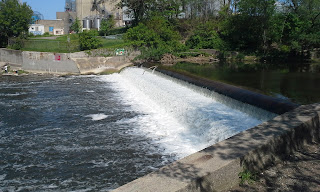London's latest interpretive sign was unveiled Thursday, May 19, 2016 in Carfrae Park on the northwest corner of Richmond and Carfrae streets. Entitled "City Mills: The Legacy of Charles Hunt," the sign is just across the Thames from the site of Charles Hunt's first business, the pioneer mill that became one of the most successful, and longest-running, in London.
Hunt immigrated to Canada from Britain at the age of 22 and worked his way up to become one of London's most important businessmen. In 1856 he established City Mills, having bought the land from John Kinder Labatt in 1853. Hunt built a dam on the Thames River and channeled water along a millrace from the river to a waterwheel at the mill. With four pairs of stones for grinding wheat, the sign tells us, the mill produced about 215 bushels of flour a day. That was enough to sell at Hunt's store on Richmond Street, The Golden Sheaf, as well as enough to sell abroad. Hunt's property eventually included a cooperage, granary, and cottages for his mill workers.
Following Charles' death in 1871, his sons Charles and John took over the mill and renamed it Hunt Bros. Ltd. In 1917, the Hunts abandoned this location and moved their operations to a six-storey flour mill powered by electricity on Nightingale Street. The new concrete structure, probably the tallest in the city at that time, was close to rail lines and could produce 1200 bushels of flour a day. A tragic fire there in 1934 took the lives of two London firefighters. The business closed in 1957, after being owned by four generations of the Hunt family.
The structure seen in the river at the original site today is not Charles Hunt's dam but a concrete weir built in the 1930s. It's a Depression-era sewer infrastructure project led by Charles' youngest son, Albert Ontario Hunt, then assistant manager of London's PUC. It's an attractive scene, though perhaps not so idyllic as the views pictured on the new sign showing the original mill and its 19th-century environs.
The sign was made possible by Albert's grandson, Jay Hunt of Ottawa, who for some time has been lobbying the city to recognize the contributions made by his grandfather. His dream finally came true at the interpretive sign unveiling Thursday morning. The night before, Jay entertained the London & Middlesex Historical Society with the story of his successful great-grandfather and the family business.
The Hunt mill may be no more but those wishing to view a working example of an old-style mill can still see vintage machinery in the London area. The Arva Flour Mill, Canada's oldest water-powered flour mill, began operations on Medway Creek in 1819. Unfortunately, federal inspectors recently decided its exposed antique rollers and leather belt-driven motors don't meet today's safety codes. The machinery came to a halt for a while but now owner Mike Matthews has been allowed to resume operations - without any staff. It's questionable how long Mr. Matthews will be able to run the mill by himself, even while the federal decision is under appeal.
Wouldn't it make sense for there to be a safety code exemption for historic facilities? Shouldn't the government regulations have a grandfather clause for a living, working museum? Many of us would say yes. Unaffordable upgrades take away the uniqueness of the mill. If you've never been to the Arva mill, get there fast.
Update, February 2017: Arva Flour Mill is now back in operation, which is good news for heritage advocates as well as local bakers. A federal tribunal overturned the 2016 safety ruling, after an appeals officer argued that mill staff are well-equipped to work the old machinery. What is still being clarified, however, is whether the owner will need additional guards on the machinery and training for staff.



















